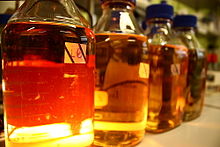LB培養基

LB培養基(Lysogeny broth,LB),是微生物學實驗中最常用的營養性培養基,用於培養大腸桿菌等細菌,分為液態培養基和加入瓊脂製成的固態培養基。加入抗生素的 LB 培養基可用於篩選以大腸桿菌爲宿主的選殖。
名稱[編輯]
儘管該培養基的名稱被廣泛解釋爲Luria-Bertani 培養基,然而根據其發明人貝爾塔尼(Giuseppe Bertani)的說法,這個名字來源於英語的 lysogeny broth,即溶菌肉湯[1]。
配方[編輯]
LB 培養基的配方發表於1951年有關溶源性的論文中。用於使志賀氏菌屬的細菌增長[1][2]。
LB培養基在1950年代曾被用作培養大腸桿菌的業界標準配方[3][4][5][6][7]。它還被廣泛應用於分子微生物學以及質體DNA的製備上,是重組大腸桿菌DNA時最常用的培養基[8]。但LB培養基不鼓勵應用於生理學研究上[9]。
每個LB培養基的配方不盡相同,但大概都會包含下列幾項:
一升水中加入:
1951年的原始論文中,貝爾塔尼在1公升的水中加入了10克的氯化鈉、1克的葡萄糖[6],但之後便剔除掉了葡萄糖。
氯化鈉的量經常隨細菌的生長需求不同而有所改變,像鹽分較低的Lennox和Luria培養基就適用於對於鹽分較敏感的抗生素實驗上[10]。
- LB-Miller (10 g/L NaCl)
- LB-Lennox (5 g/L NaCl)
- LB-Luria (0.5 g/L NaCl)
製備方法[編輯]

加水至1L並調pH值至7.0後高溫滅菌。如需要製成固態培養基,在調pH值後加入1.5%(質量體積比,即每升培養基中加入15克)的瓊脂再滅菌。
參見[編輯]
參考文獻[編輯]
- ^ 1.0 1.1 Giuseppe Bertani. Lysogeny at mid-twentieth century: P1, P2, and other experimental systems. Journal of Bacteriology. 2004-02, 186 (3): 595–600 [2019-02-13]. ISSN 0021-9193. PMC 321500
 . PMID 14729683. doi:10.1128/JB.186.3.595-600.2004. (原始內容存檔於2019-08-13).
. PMID 14729683. doi:10.1128/JB.186.3.595-600.2004. (原始內容存檔於2019-08-13).
- ^ Bertani, G. (1951). Studies on lysogenesis. I. The mode of phage liberation by lysogenic Escherichia coli. J. Bacteriol. 62:293-300. PMID 14888646 PDF
- ^ Miller, J. H. (1972). Experiments in molecular genetics. Cold Spring Harbor Laboratory, Cold Spring Harbor, New York.
- ^ Luria, S. E., J. N. Adams, and R. C. Ting. (1960). Transduction of lactose-utilizing ability among strain of E. coli and S. dysenteriae and the properties of the transducing phage particles. Virology. 12:348-390. PMID 13764402
- ^ Lennox, E. S. (1955). Transduction of linked genetic characters of the host by bacteriophage P1. Virology. 1:190-206. PMID 13267987
- ^ 6.0 6.1 Luria, S. E., and J. W. Burrous. (1957). Hybridization between Escherichia coli and Shigella. J. Bacteriol. 74:461-476. PMID 13475269 PDF
- ^ Anderson, E. H. (1946). Growth requirement of virus-resistant mutants of Escherichia coli strain B. Proc. Natl. Acad. Sci. USA 32:120-128. PMID 16588724
- ^ Sambrook, J., E. F. Fritsch, and T. Maniatis. (1989). Molecular cloning: a laboratory manual, 2nd edition. Cold Spring Harbor Laboratory, Cold Spring Harbor, New York.
- ^ Nikaido, H. (2009). The Limitations of LB Medium. Small things considered - The Microbe Blog. ASM. http://schaechter.asmblog.org/schaechter/2009/11/the-limitations-of-lb-medium.html (頁面存檔備份,存於網際網路檔案館)
- ^ Commonly used bacterial E.coli growth media. Expression Technologies Inc. http://www.exptec.com/Reagents/Common%20Media.htm (頁面存檔備份,存於網際網路檔案館)
